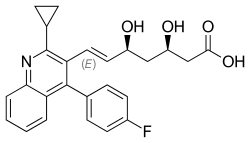Pitavastatin
Pitavastatin (usually as a calcium salt) is a member of the blood cholesterol lowering medication class of statins.[1]
 | |
| Clinical data | |
|---|---|
| Trade names | Livalo, Livazo, others |
| AHFS/Drugs.com | Monograph |
| MedlinePlus | a610018 |
| License data |
|
| Pregnancy category | |
| Routes of administration | By mouth (tablets) |
| ATC code | |
| Legal status | |
| Legal status | |
| Pharmacokinetic data | |
| Bioavailability | 60% |
| Protein binding | 96% |
| Metabolism | Liver (CYP2C9, minimally) |
| Elimination half-life | 11 hours |
| Excretion | Faeces |
| Identifiers | |
IUPAC name
| |
| CAS Number | |
| PubChem CID | |
| IUPHAR/BPS | |
| ChemSpider | |
| UNII | |
| ChEBI | |
| ChEMBL | |
| CompTox Dashboard (EPA) | |
| ECHA InfoCard | 100.171.153 |
| Chemical and physical data | |
| Formula | C25H24FNO4 |
| Molar mass | 421.461 g·mol−1 |
| 3D model (JSmol) | |
SMILES
| |
InChI
| |
| | |
Like other statins, it is an inhibitor of HMG-CoA reductase, the enzyme that catalyses the first step of cholesterol synthesis.
It was patented in 1987 and approved for medical use in 2003.[2] It is available in Japan, South Korea and in India.[3] In the US, it received FDA approval in 2009.[4] Kowa Pharmaceuticals is the owner of the American patent to pitavastatin.
Medical uses
Like the other statins, pitavastatin is indicated for hypercholesterolaemia (elevated cholesterol) and for the prevention of cardiovascular disease.
A 2009 study of the 104 week LIVES trial found pitavastatin increased HDL cholesterol, especially in patients with HDL lower than 40 mg/dL, who had a 24.6% rise, in addition to greatly reducing LDL cholesterol 31.3%.[5] HDL improved in patients who switched from other statins and rose over time. In the 70-month CIRCLE observational study, pitavastatin increased HDL more than atorvastatin.[6]
It has neutral or possibly beneficial effects on glucose control. As a consequence, pitavastatin is likely to be appropriate for patients with metabolic syndrome plus high LDL, low HDL and diabetes mellitus.
Side effects
Common statin-related side effects (headaches, stomach upset, abnormal liver function tests and muscle cramps) were similar to other statins. However, pitavastatin seems to lead to fewer muscle side effects than certain statins that are lipid-soluble, as a result of the fact that pitavastatin is water-soluble (as is pravastatin, for example).[7] One study found that coenzyme Q10 was not reduced as much as with certain other statins (though this is unlikely given the inherent chemistry of the HMG-CoA reductase pathway that all statin drugs inhibit).[8][9]
As opposed to other statins, there is evidence that pitavastatin improves insulin resistance in humans, with insulin resistance assessed by the homeostatic model assessment (HOMA-IR) method.[10]
Hyperuricemia or increased levels of serum uric acid have been reported with pitavastatin.[11]
Metabolism and interactions
Most statins are metabolised in part by one or more hepatic cytochrome P450 enzymes, leading to an increased potential for drug interactions and problems with certain foods (such as grapefruit juice). The primary metabolism pathway of pitavastatin is glucuronidation. It is minimally metabolized by the CYP450 enzymes CYP2C9 and CYP2C8,[12] but not by CYP3A4 (which is a common source of interactions in other statins). As a result, it is less likely to interact with drugs that are metabolized via CYP3A4, which might be important for elderly patients who need to take multiple medicines.[8]
History
Pitavastatin (previously known as itavastatin, itabavastin, nisvastatin, NK-104 or NKS-104) was discovered in Japan by Nissan Chemical Industries and developed further by Kowa Pharmaceuticals, Tokyo.[8] Pitavastatin was approved for use in the United States by the FDA on 08/03/2009 under the trade name Livalo. Pitavastatin has been also approved by the Medicines and Healthcare products Regulatory Agency (MHRA) in UK on 17 August 2010.
Names
The drug is marketed in the United States under the trade name Livalo, and in the European Union and Russia under the trade name Livazo.
References
- Kajinami, K; Takekoshi, N; Saito, Y (2003). "Pitavastatin: efficacy and safety profiles of a novel synthetic HMG-CoA reductase inhibitor". Cardiovascular drug reviews. 21 (3): 199–215. PMID 12931254.
- Fischer, Jnos; Ganellin, C. Robin (2006). Analogue-based Drug Discovery. John Wiley & Sons. p. 473. ISBN 9783527607495.
- Zydus Cadila launches pitavastatin in India
- The Seventh Statin; Pitavastatin
- Teramoto, T; Shimano, H; Yokote, K; Urashima, M (October 2009). "Effects of pitavastatin (LIVALO Tablet) on high density lipoprotein cholesterol (HDL-C) in hypercholesterolemia". J Atheroscler Thromb. 16: 654–61. doi:10.5551/jat.1719. PMID 19907105.
- Masana, L (30 May 2013). "Pitavastatin in cardiometabolic disease: therapeutic profile". Cardiovasc Diabetol. 12 Suppl 1: S2. doi:10.1186/1475-2840-12-S1-S2. PMC 3668168. PMID 23819752.
- ScienceDaily (11 May 2013). "Alternative Cholesterol-Lowering Drug for Patients Who Can't Tolerate Statins". ScienceDaily.
- Mukhtar, R. Y. A.; Reid, J.; Reckless, J. P. D. (2005). "Pitavastatin". International Journal of Clinical Practice. 59 (2): 239–252. doi:10.1111/j.1742-1241.2005.00461.x. PMID 15854203.
- Kawashiri, MA; Nohara, A; Tada, H; Mori, M; Tsuchida, M; Katsuda, S; Inazu, A; Kobayashi, J; Koizumi, J; Mabuchi, H; Yamagishi, M (May 2008). "Comparison of effects of pitavastatin and atorvastatin on plasma coenzyme Q10 in heterozygous familial hypercholesterolemia: results from a crossover study". Clin Pharmacol Ther. 83 (5): 731–9. doi:10.1038/sj.clpt.6100396. PMID 17957184.
- Nakagomi, A; Shibui, T; Kohashi, K; Kosugi, M; Kusama, Y; Atarashi, H; Shimizu, W (2015). "Differential Effects of Atorvastatin and Pitavastatin on Inflammation, Insulin Resistance, and Carotid Intima-Media Thickness in Patients with Dyslipidemia". Journal of Atherosclerosis and Thrombosis. 22: 1158–1171. doi:10.5551/jat.29520.
- Ogata, N.; Fujimori, S.; Oka, Y.; Kaneko, K. (2010). "Effects of Three Strong Statins (Atorvastatin, Pitavastatin, and Rosuvastatin) on Serum Uric Acid Levels in Dyslipidemic Patients". Nucleosides, Nucleotides and Nucleic Acids. 29 (4–6): 321–324. doi:10.1080/15257771003741323.
- Drugs.com: Livalo Monograph.